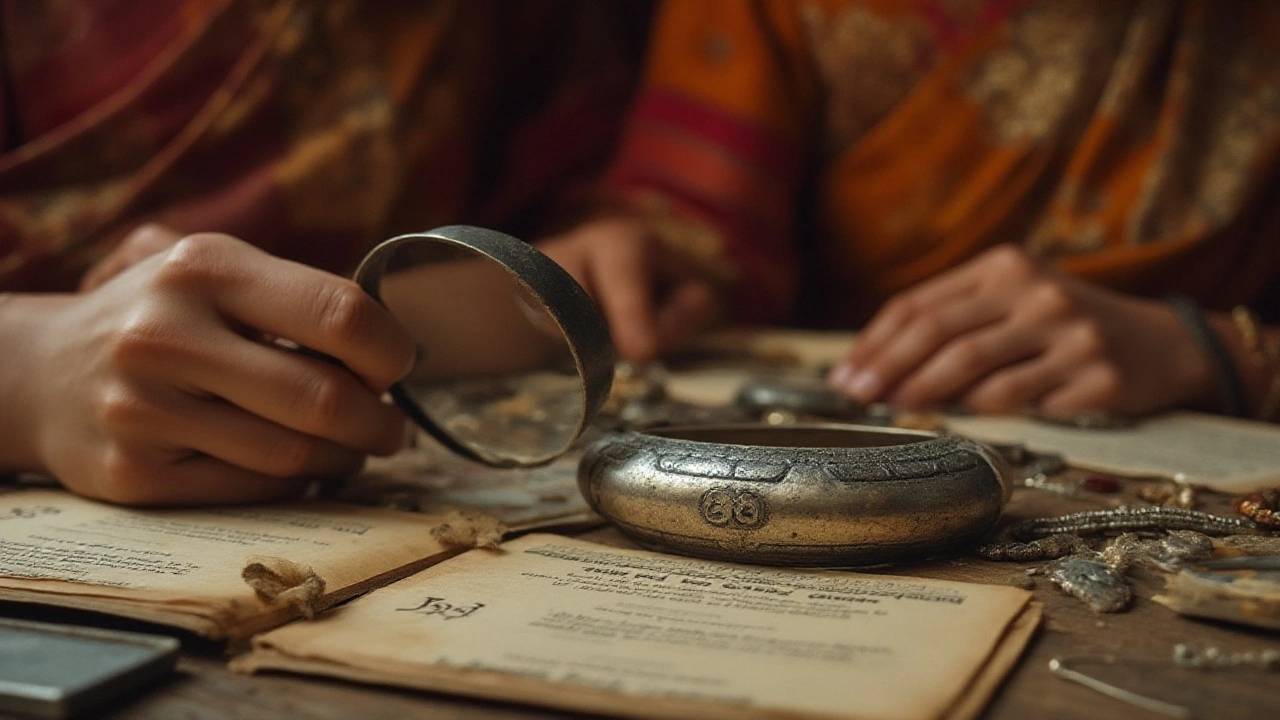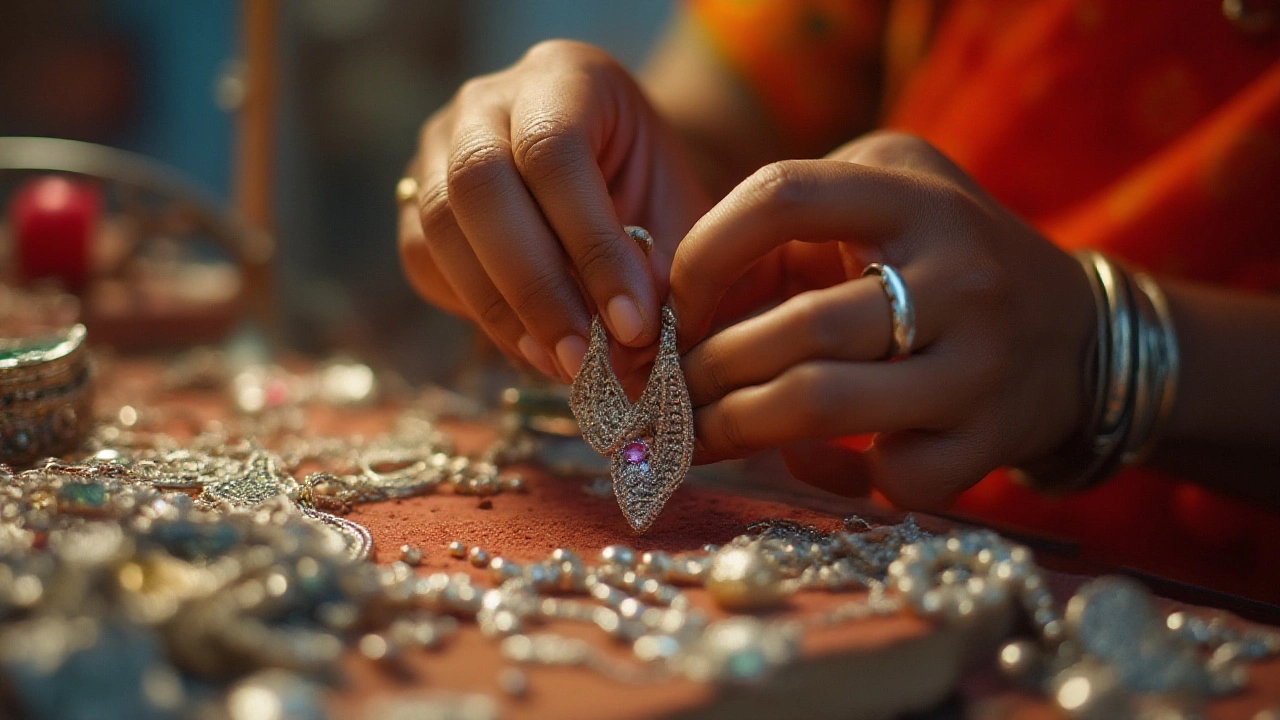If you’ve ever flipped over a silver necklace, ring, or pendant and spotted the number “833” stamped where nobody usually looks, you probably had that little flash of curiosity. Is this a code? A random engraving? Or does it hide some secret worth knowing before you splurge on that gorgeous vintage chain? The world of silver markings might seem like a puzzle at first, but trust me, once you unlock it, everything suddenly makes sense—and you’ll never look at a piece of jewelry the same way again.
What 833 Means: Breaking Down Silver Purity Codes
Let’s start by cracking that “833” code. In the jewelry world, especially when it comes to silver, numbers like 833, 925, or 800 tell you about the purity of the metal in the piece. “833” means that the item is made of 83.3% pure silver—the rest, usually copper or another metal, is added to make the jewelry strong enough for daily wear. It's what pros call a 'millésimal fineness' stamp. Compare it to the more common “925” (that’s sterling silver, for the trivia-minded), which is 92.5% silver. Wondering why we don’t use 100% silver in most jewelry? Pure silver is soft, bends, dents, and scratches easier than you’d like. So alloying it with tougher metals lets your jewelry actually survive life in your jewelry box—or on your finger as you wrestle with your keys.
In Europe, especially in places like the Netherlands and Scandinavia, the 833 standard caught on big across the 19th and early 20th centuries. If your grandmother’s silver ring from Denmark sports an “833” mark, it’s a clue to when and where it was made. These fineness marks aren’t just about nerdy specs—they can tell you the whole story behind your jewelry. You’ll spot 833 silver less often in the US or UK, because these countries skipped right to sterling (925) as their legal silver standard, so many American jewelers wouldn’t bother with 833 items. Some countries, like Portugal, had even more unusual standards—look out for 835 or even 800 in antiques there.
Why does that small difference in percentage (83.3% vs. 92.5%) matter? Well, 833 silver is slightly less white and may tarnish a bit faster than sterling, but the difference is pretty subtle to the naked eye. For many people, it’s about heritage—owning a piece of 833 silver is like holding a little slice of European history. If you see jewelry labeled as “coin silver”, don’t confuse it—especially in the US, this refers to about 90% silver, from old coins melted down, not the same as 833. Got a microscope and want to look really closely? Purity might affect how the metal polishes up, how it handles engraving, and even how it ages over decades.

Comparing 833 to Other Silver Grades (With Real-World Examples and Data)
Now let’s dig a little deeper. In the jewelry and cutlery world, a bunch of silver standards compete for your attention, and knowing which mark matches which country or era can put you ahead when you’re hunting for a bargain at an antique fair—or just online.
The heavy-hitter here is 925 (sterling silver). It’s the legal standard in the UK and most English-speaking countries, and the one you’ll see most often in modern jewelry and flatware. Go a little lower, and you get 900 (coin silver, mostly in North America), then 835 and 833—especially popular in the Netherlands, Denmark, Norway, Finland, and sometimes Germany and France. There’s also 800 silver, found in old European pieces, and if you really want to get obscure, countries like Switzerland once used even lower standards (like 700).
Check out this cheat-sheet for common silver purity marks and where you’ll spot them most:
| Mark | Silver Content (%) | Typical Country/Region | Common Use/Period |
|---|---|---|---|
| 999 | 99.9 | China, worldwide (bullion) | Bullion bars, coins, investment |
| 925 | 92.5 | UK, US, India, worldwide | Sterling jewelry and household silver |
| 900 | 90 | US (historical) | Antique coin silver (pre-1965) |
| 835 | 83.5 | Portugal, Scandinavia | Vintage cutlery, jewelry, holloware |
| 833 | 83.3 | Netherlands, Scandinavia | 19th-20th century jewelry, decorative items |
| 800 | 80 | Germany, Italy, France | Antique European silver |
Here’s the kicker: in physical use, you probably won’t notice a massive difference between, say, 833 and 925 silver jewelry. They all tarnish, though tarnish can show up quicker at lower purity. They all need the same gentle cleaning and storage (grab a soft cloth and a zip-lock bag, forget those abrasive pastes you see at the supermarket). If you’re allergic to mixed metals, look out—lower purity means more copper or other alloy metals, which could bother sensitive skin. My spouse, Pooja, found out the hard way when an 800 silver bangle made her wrist itch, while 925 was just fine.
For the investment-minded, sterling (925) is a little more valuable for resale, simply because of the higher silver content. But rare or beautifully made 833 pieces, especially from niche makers, can be worth just as much—sometimes even more if they're part of a famous set or come from a sought-after time period. Collectors love the backstory and craftsmanship. The Dutch, for example, were masters at bold, sculptural 833 silver jewelry during the Art Nouveau era.
Here’s something to keep in mind: silver prices are set by weight and purity. Meaning, if you have a chain marked 833 and a chain marked 925, both weighing 20 grams, the sterling piece will have a bit more silver scrap value. But let’s be honest—most people aren’t melting down jewelry for the silver content; they’re wearing and gifting it, where design matters more than raw numbers.
Watch out for tricks, though. Some fakes fake a “833” mark just because they know it’s less familiar to modern buyers, so always check for other hallmarks—maker’s marks, national symbols (like tiny crowns, lions, or letters), or even official assay office stamps. These extra clues help confirm that you’re dealing with the genuine article. If you’re scouring vintage shops or online auctions, always ask for clear photos of the marks and, if possible, get the weight too.

What to Consider Before Buying or Selling 833 Silver Jewelry
So let’s say you spot a lovely 833-marked ring or brooch at a flea market. Do you buy, sell, or skip? Here’s how to decide.
First, always check authenticity. Real silver is non-magnetic, has a clear, ringing sound when tapped (I use a metal pen or the edge of my ring), and usually feels cool to the touch, unlike fake-plated metals. If the piece is dark or tarnished, don’t panic—that’s normal for silver, especially older alloys like 833. In fact, sometimes a little tarnish adds character and hints at a great story. And if you love the look of antique pieces, those subtle differences in tone between 833 and 925 can actually make them pop in a jewelry stack or collection.
Look for these hallmarks of genuine 833 silver:
- Stamp: Properly and clearly struck “833” in a simple font (blurred or off-center stamps can sometimes mean it’s fake or refurbished)
- Maker’s mark: Usually some tiny initials, symbols, or a logo near the fineness number
- National mark: In the Netherlands, official hallmarks often featured a tiny sword or lion
- Not magnetic: Test with a small fridge magnet—it shouldn’t stick
- Mild tarnish pattern: Genuine silver tarnishes in a dark grayish way, not bright green (that’s often a copper reaction)
Selling? Not all jewelers are familiar with 833 silver outside Europe, so educate them and push the heritage angle—mention the country, date, and style. A nicely documented provenance can boost value, especially for collectors of Dutch or Scandinavian vintage. We once sold a set of 833 Norwegian silver spoons with a hand-written note describing their 1920s family origin, and the buyer paid nearly double than if we’d just listed them as “old silver spoons.”
Buying online? Stick with sellers who provide close-ups of hallmarks and disclose any repairs or modifications (lots of antiques get new clasps, and these may not always be the same purity as the original piece). If someone claims it’s “pure” silver but the only mark is “833,” they either don’t know their stuff, or they’re trying to pull a fast one. Double-check with a reputable jeweler if you’re investing serious money.
Worried about care and cleaning? No fancy kit needed. Gently polish with a microfiber cloth, or if it needs a deep clean, try a lukewarm bath with mild soap (skip the harsh cleaners or sonic machines, as these can damage soft stones or enameling). Store 833 jewelry away from direct sunlight and moisture—if you’re as absent-minded as me, just toss in a little silica gel pack from your last shoe purchase into the jewelry drawer. Works wonders.
If you’re in love with vintage looks, 833 silver is a goldmine for character: the castings are often chunkier, the designs more dramatic, and you get that “someone actually made this by hand” feeling, versus some modern mass-market chains. Jewelry with this mark might just become your quiet little boast—a subtle way to say, “I know my history, and I care about quality.” And who knows, maybe you’ll spot an “833” brooch at a market, snag it for a steal, and years later, find it’s from a famous Danish designer. Now that’s the kind of treasure hunt I love.
So next time you flip over a piece of silver and see the numbers 833, remember: you’re holding more than just a pretty accessory—you’re holding a bit of the past, crafted to stand the test of time, and still ready for you to wear loud and proud today.



